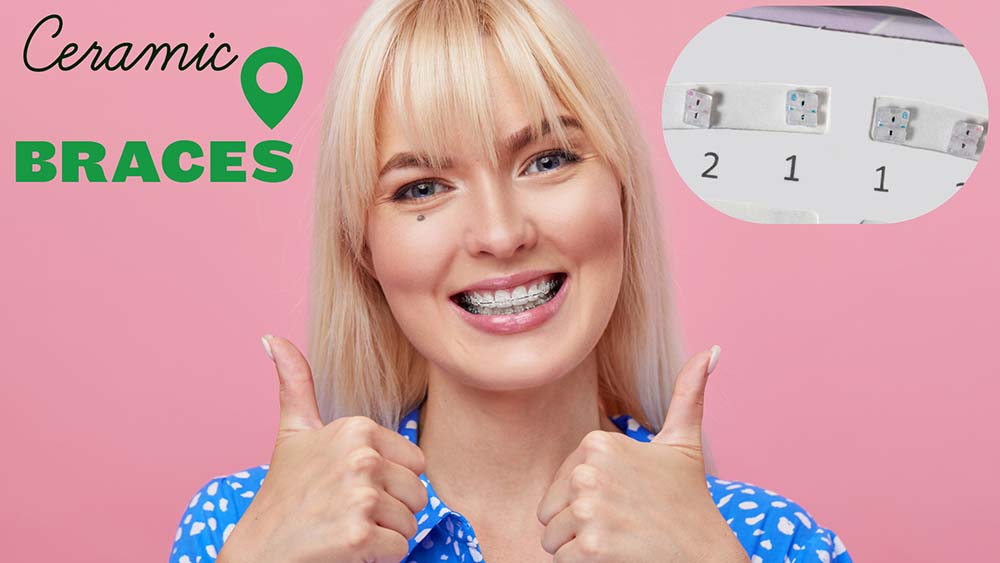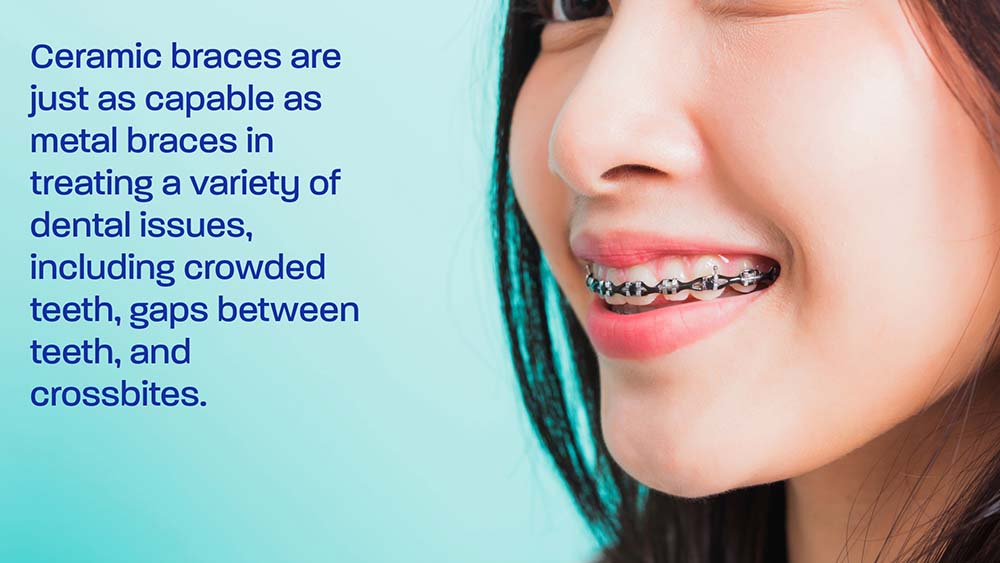Ceramic Braces. Smile Bold.
Only for boundary-breakers .


Beyond the dentristy.
If you've ever lost a tooth or needed a replacement, you might have heard about Ceramic Braces.
They are a popular solution that not only looks and feels like your natural teeth but also offers long-term benefits. In this page, we’ll walk you through everything you need to know about ceramic Braces in a simple and easy-to-understand way.
Ceramic Braces

Braces often bring to mind images of shiny metal brackets and that unmistakable "metal mouth" look. Fortunately, there’s a stylish alternative: ceramic braces! These braces work much like their metal counterparts but stand out far less, thanks to their clear or tooth-colored materials. Blending seamlessly with your teeth, they provide an aesthetic way to straighten your smile without drawing attention. This makes them a top choice for teens and adults who want to enhance their appearance discreetly.
The story of ceramic braces stretches back to the 1980s, when a ceramic material developed with NASA’s help kickstarted their commercial use. Though early versions were somewhat fragile, advancements over the years have made them stronger and more reliable. Today, they’re a popular pick in orthodontics, especially for those prioritizing both function and style. Adults, in particular, love them for correcting their teeth without the bold metal look. In short, ceramic braces deliver a perfect mix of effectiveness and elegance!

Ceramic brackets work with the same logic as metal brackets. The basic components are brackets, archwires and elastic ties. The difference is that the ceramic brackets are transparent or tooth-coloured. They are bonded to the teeth with a special adhesive, an archwire is threaded through the brackets and this wire applies gentle pressure to the teeth, bringing them into alignment over time. In other words, they use the power of metal brackets, but they are much less conspicuous.
The biggest difference from metal brackets is aesthetics. Ceramic braces can be a little more fragile, but their modern designs are very durable. They have the same success in tooth alignment as metal braces and can solve even complex problems.
Generally, anyone whose permanent teeth have completely erupted can be a candidate, but mostly young people and adults prefer them. If you ask why, the aesthetic advantages are great. The fact that they are less visible in school photos or business meetings is ideal for adolescents and professional adults. Metal braces are generally recommended for children because they are both more durable and more economical.
Ceramic braces can solve all the problems treated by metal braces such as tooth crowding, spaced teeth, crossbite. While they offer an aesthetic advantage for adults, cost and maintenance requirements can be disadvantages. For teenagers, however, they provide the perfect balance between appearance and effectiveness. If you care about your appearance and can take care of yourself, ceramic brackets may be for you!
Ceramic Braces vs. Metal Braces
Let's compare ceramic and metal brackets. There is a clear difference in appearance: ceramic brackets are transparent or tooth-coloured, while metal brackets stand out immediately with their steel colour. Both are equal in effectiveness; they can solve any dental problem. Metal is ahead in durability, while ceramic is a little more sensitive. As ceramic brackets are smoother in comfort, they do not irritate the mouth much. The treatment time is generally the same, but if the ceramic bracket breaks, additional visits may be required. In terms of cost, ceramic is more expensive and care should be more careful because of the risk of staining. If aesthetics are a priority, ceramic braces win!
Ceramic Braces vs. Invisalign

Now let's compare them with transparent aligners (Invisalign). In appearance, Invisalign is almost completely invisible, while ceramic brackets can be recognised up close. You can remove Invisalign while eating, but the ceramic brackets are fixed. Invisalign is ahead in comfort, and ceramic brackets are not bad with their smooth design. In effectiveness, ceramic braces are better in complex cases, while Invisalign is suitable for mild to moderate cases. Invisalign is easier to maintain, ceramic braces require care due to the risk of stains. Costs are similar. If you want a balance between appearance and effectiveness, ceramic brackets are a nice middle ground!
Advantages
The biggest advantage of ceramic braces is that they are aesthetic. With their transparent structure, your smile remains natural and no one notices your braces. This allows you to maintain your self-confidence. They can solve even complex dental problems; you don't have to postpone treatment due to aesthetic concerns. With their smooth surface, they irritate your mouth less and do not cause problems in tests such as MRI. You can personalise them with elastic ties; you can reflect your style with transparent or coloured elastics. They are also great for metal allergy sufferers because they are metal-free. Sometimes they can give fast results even from transparent plates. Both beautiful and effective!
Disadvantages
The cost is higher than metal brackets, which may strain your budget. Tyres can be stained by things like coffee and tea, but if you brush them regularly, this is not a problem. They are not as strong as metal in terms of durability; they can break if you eat something hard. They are slightly larger in size, taking up more space in your mouth. If breakage occurs, additional checks may be required. You need to be diligent in care; you need to watch what you eat to reduce the risk of stains and fractures. They cannot be applied to every tooth; sometimes a hybrid solution may be required. But the aesthetic advantage balances these cons.
The process of wearing ceramic braces is the same as metal braces. First, you see your orthodontist. Your teeth are prepared, brackets are glued one by one, and arch wire is passed and fixed with elastic. The procedure takes 1-2 hours and is painless. During the treatment, you go for a check-up every 4-6 weeks; the wire is changed or tightened. The duration varies between 18-36 months depending on the difficulty of the case. There may be some pain in the first days, but it is temporary. It is easily overcome with painkillers and a soft diet. Your orthodontist will give you wax; use it if irritation occurs. Be patient, you get used to it soon!
Cleaning of ceramic brackets is critical. You should brush after every meal and floss once a day. Intermediate toothbrushes are very useful for cleaning around the bracket. To avoid staining, avoid coffee, tea, red wine, or brush immediately. Avoid hard (nuts, sugar) and sticky (caramel, chewing gum) foods; these can damage the brackets. Cut hard things like apples, not bite them. If you follow these rules, the treatment will go smoothly.
Ceramic brackets cost between $4,000-8,000. They are slightly more expensive than metal brackets. Insurance usually covers part of the orthodontic treatment, but not all of it. The price varies according to your area and the difficulty of the treatment, so I recommend you get a clear quote. Below you can examine the prices of ceramic braces in different countries.
| Country | Ceramic Braces Cost (Approx. Range) | Insurance / Financing Factors | Cost vs. Metal Braces |
|---|---|---|---|
| United Kingdom (UK) | £2,000–£4,500 | NHS covers braces for under-18s with medical need (free, usually metal braces) Adults generally pay privately; many clinics offer 0% installment plans for treatment Private dental insurance typically provides limited orthodontic coverage. |
Traditional metal braces cost about £1,500–£3,000, so ceramic braces are slightly more expensive (due to the cosmetic clear brackets). |
| United States (USA) | $4,000–$8,000 | Dental insurance often covers ~50% of orthodontic costs for minors (commonly up to ~$1,500 lifetime max) Coverage for adults is rare (most plans won’t pay for adult braces). Many patients use payment plans, HSAs/FSAs, or dental financing to manage out-of-pocket costs. |
Traditional metal braces average around $3,000–$7,000. Ceramic braces tend to cost a few hundred to ~$1,000 more in total, given the higher material cost (about ~10–20% premium over metal). |
| Turkey | ₺40,000–₺70,000 (Turkish Lira) (≈ $1,500–$2,500) | Lower-cost market – treatment is often 50–70% cheaper than in the UK or USA. Public insurance offers minimal coverage for orthodontics; most patients pay out-of-pocket. Many Turkish clinics offer monthly installment plans for locals and all-inclusive packages (including accommodation/transfers) to international patients as part of Turkey’s medical tourism. |
Metal braces in Turkey cost roughly ₺40,000–₺55,000 for a full treatment. Ceramic braces are only slightly higher in price, so even clear/ceramic options in Turkey remain far cheaper than metal braces in Western countries. |
| Germany | €5,000–€8,000 (Euros) | Public statutory insurance covers standard braces for children/teens with significant need (primarily metal braces). Aesthetic options like ceramic brackets are considered upgrades and not covered by basic insurance – these require out-of-pocket payment or private insurance. Adults typically pay privately (unless having supplemental orthodontic insurance). Many orthodontists offer financing plans to spread the cost. |
Traditional metal braces typically range ~€5,000–€7,000 in Germany. Ceramic braces usually carry an extra fee (often a few hundred euros per arch), making total treatment cost about €500–€1,000 more than metal on average. |
Ceramic braces offer a perfect balance between aesthetics and effectiveness, making them an excellent choice for those who want to straighten their teeth discreetly. For expert orthodontic care, **Avita Smile** is a name you can trust. For the past 20 years, Avita Smile has been one of the most visited clinics in Antalya by European patients, providing high-quality orthodontic treatments at European standards. With experienced orthodontists and state-of-the-art technology, the clinic ensures that patients receive exceptional care and achieve beautiful, healthy smiles. Whether you are looking for ceramic braces or other orthodontic solutions, Avita Smile offers expert guidance and personalized treatment options to help you achieve your dream smile.
Timeline to your new smile.
A more beautiful version of your present smile.
Dental Health is our super and only one specialisation.
Dental & oral health is our passion. The goal is a less obvious, natural and more beautiful version of your current smile and oral health.
Bright smile.
Illuminate your world with a smile that shines bright and exudes confidence.
Confidence booster.
Unlock your true potential with a smile that boosts your confidence.
Pure & perfect.
Experience the pinnacle of dental perfection with avita dental treatments.









